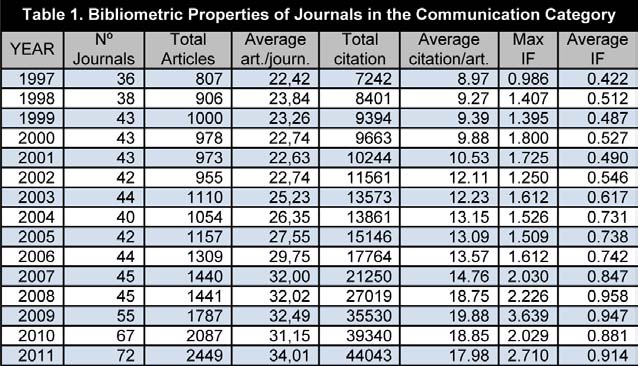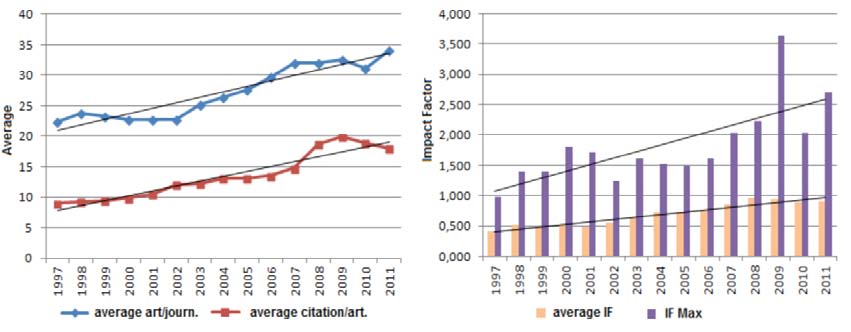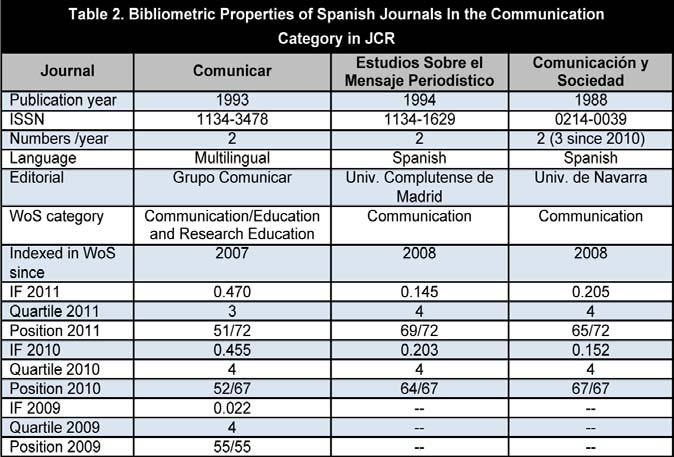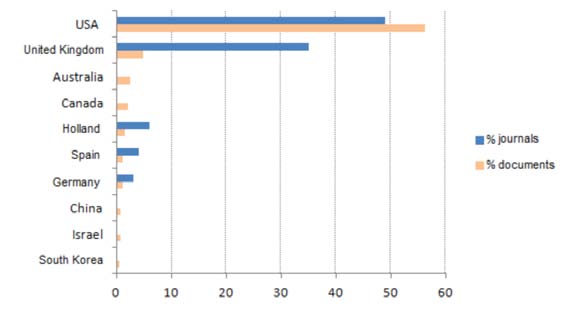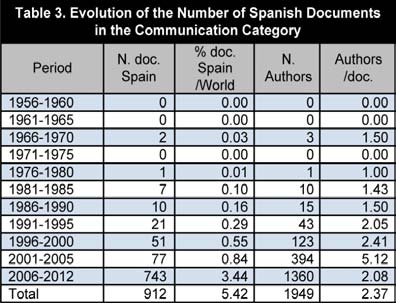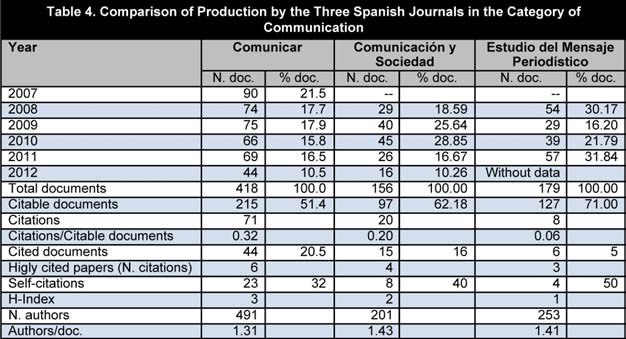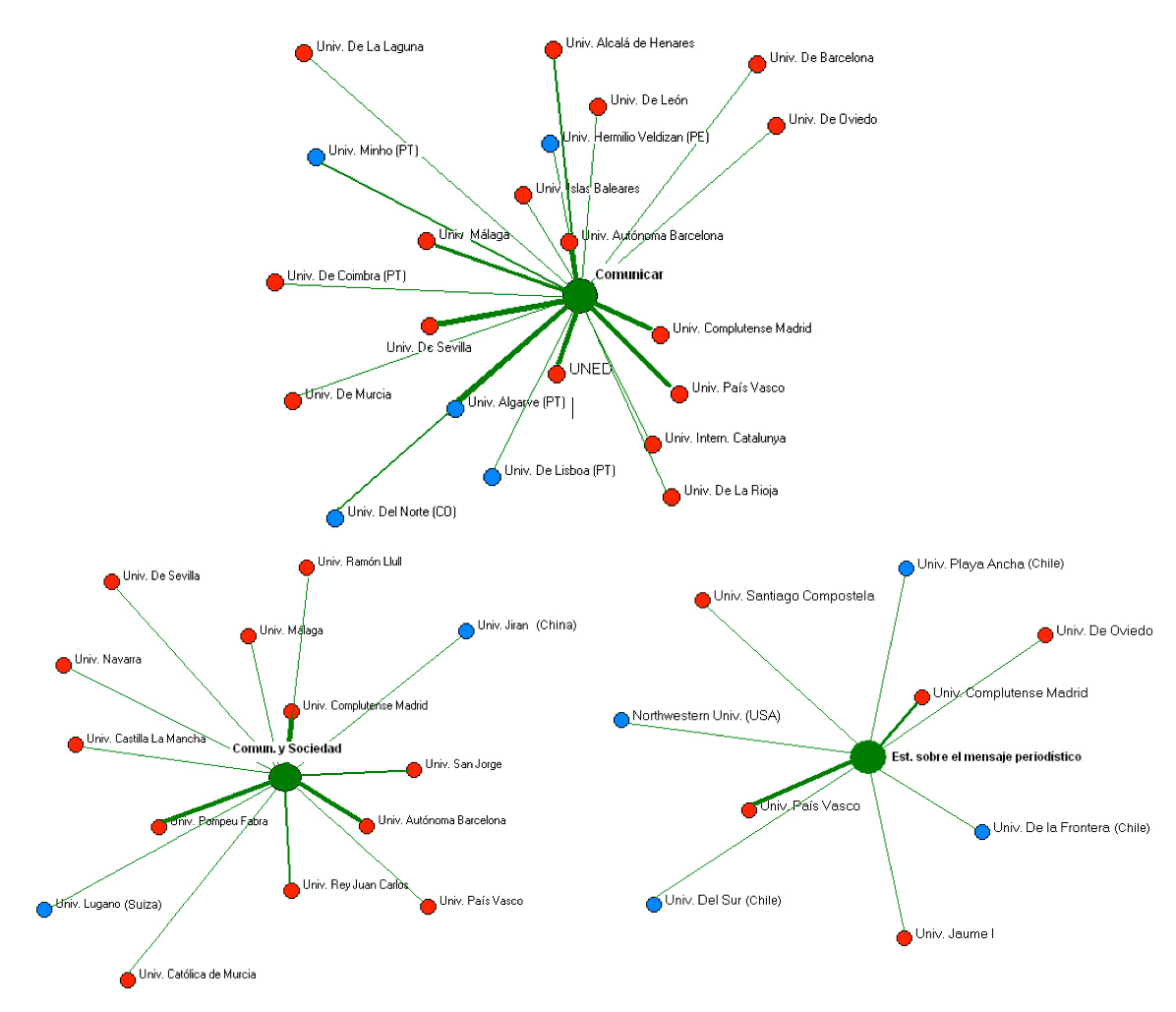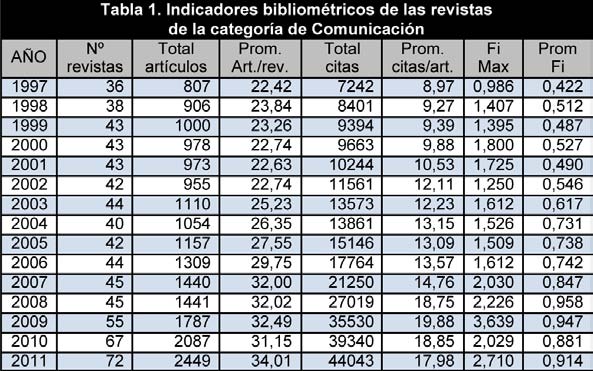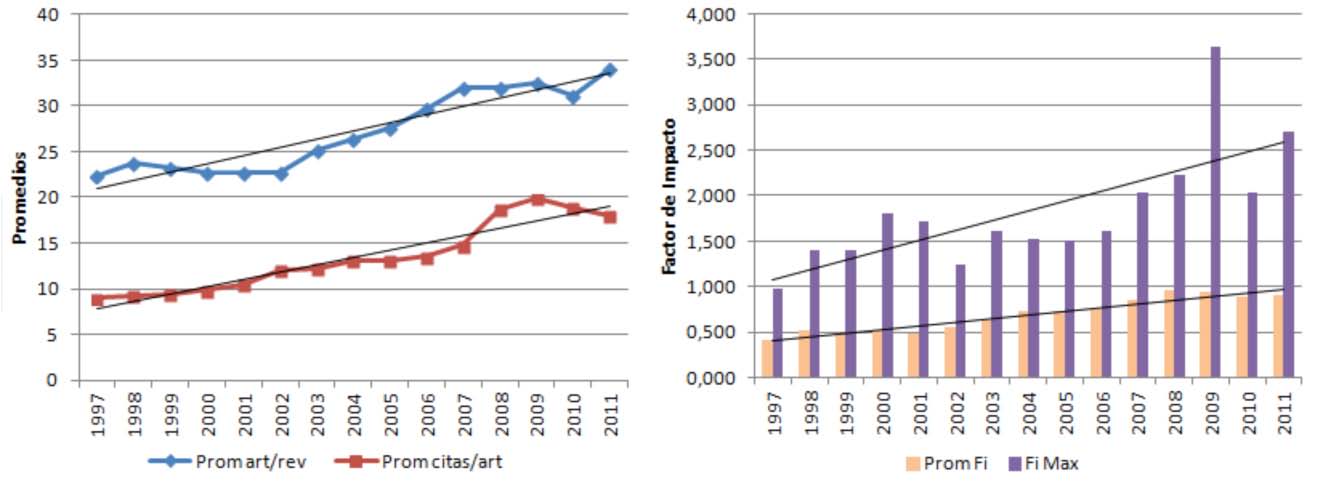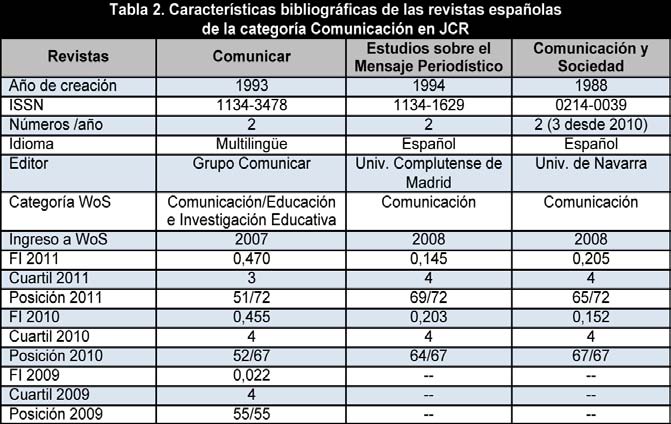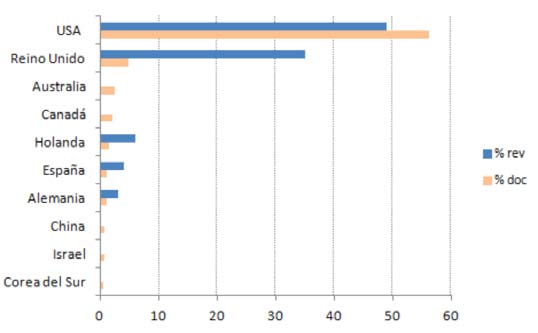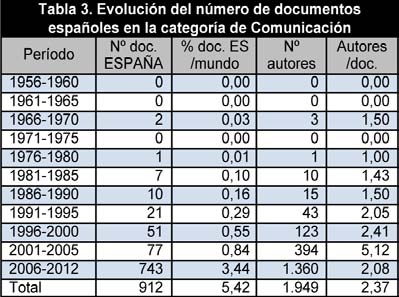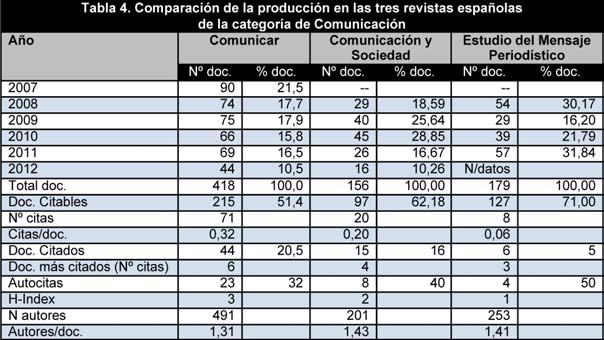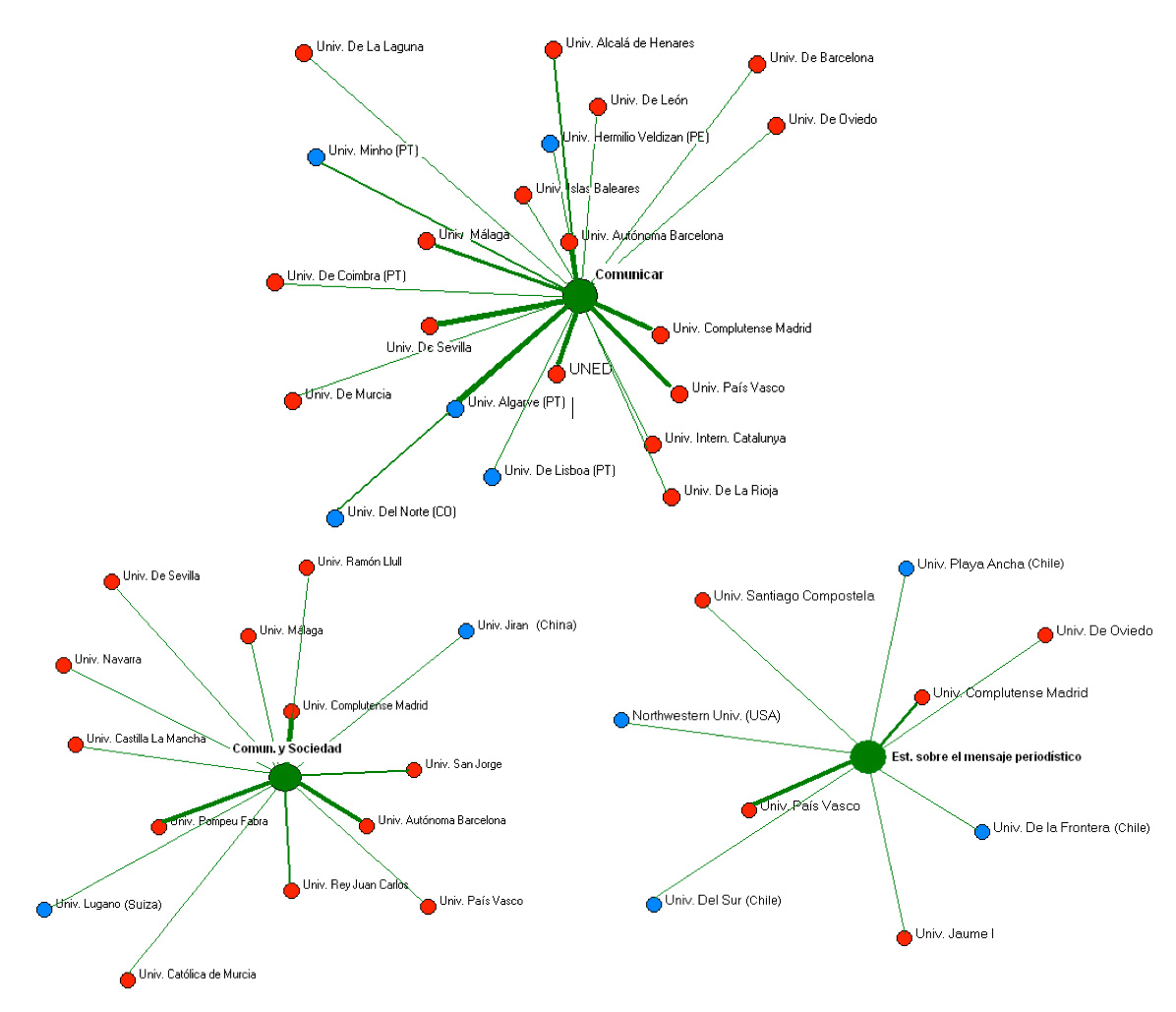Pulsa aquí para ver la versión en Español (ES)
Abstract
Although the field of Communication Sciences has been slower to organize in Spain than in other European countries and the United States, in recent years it has shown a clear tendency to growth. One way to trace this process is by analyzing scientific production, and this paper focuses on this aspect. Using bibliometric methods, we analyze scientific journals and papers indexed in Thomson Reuter’s international database, the Social Science Citation Index (SSCI) for Communication. While the focus of the study is Spanish scientific output, the results are related to international activities in this field. The three Spanish journals included in SSCI in recent years: «Comunicar», «Comunicación y Sociedad» and «Estudios sobre el Mensaje Periodístico» were studied in detail. The results show that Spain plays an important role in Communcation journal publishing (4th in the world) and as a producer of scientific papers (6th in the world), with a remarkable evolution, in quantitative terms, especially in the last five years. The inclusion of these three Spanish journals in the international database has been an important contribution to the country's visibility in this field, but there is still a need to promote international collaboration to achieve greater impact and openness in the scientific community.
1. Introduction
It is possible to find Communication literature in Spain dating from the end of the XIX century through to the first works that deal with the study of the press, public opinion and cartoon humor. However, the consolidation of Communication as an academic field has been slower in Spain than in Europe and the United States (Jones, 1998).
Despite the subsequent strengthening of this discipline in Spain, a major evolution has taken place through different stages of emergence, consolidation and development (Martínez-Nicolás, 2009). Within each of these stages, a critical grouping of institutions, professionals and researchers has been built up, facilitating the institutionalization of the field. Not only has this process been possible thanks to the changes in the Communications systems and in their internal logics, it has been also possible due to the significant role that Communications increasingly plays in the development of our social systems (Moragas, 1997). The creation of academic and professional journals, which have served as a meeting point for the debates on methodology as well as diffusion channels for the results obtained, has played a role in this field’s evolution and development.
From the appearance of the first publications on Communication to now, more than 40 national titles with different degrees of periodicity and continuity can be tracked. The existence of multiple publications reflects a will to consolidate a field in continuous growth. This trend is also evident through the increasing emphasis on improving the quality of publications, which have to adapt themselves to the strict criteria applied by evaluation agencies. Achieving the incorporation of Spanish journals into different databases constituted one of the main challenges, as this involved the recognition of the quality of such publications and their subsequent opening to the international community.
Many efforts have been carried out to improve the quality of Communication journals. Among these are the work carried out by publishers, who have prompted important changes to adapt themselves to the international rules for scientific publishing. Similarly, the work carried out by professionals linked to the field of evaluation, who have designed and applied quality indicators to Spanish publications so that they are valid within the existing evaluation systems, should also be acknowledged (Giménez, 2011).
The incorporation of Spanish journals into international databases has also contributed to identify the publications with greater quality within the field. Authors such as Fernández-Quijada (2010) have used these criteria to identify the major publications in the field within resources such as DICE, Latindex and In-RECS, constituting one of the criteria for positive evaluation within evaluation Studies by Social Science and Humanities journals such as the REHS project by CSIC (Giménez & Alcaín, 2006). These criteria are also used in other initiatives such as MIAR (led by the University of Barcelona) or the In-RECS platform (led by the University of Granada).
In the last few years, this tendency to include Communication journals within international databases has impacted on the overall area of Social Sciences. In the case of the Social Science Citation Index database, there has been a noticeable increase in the presence of Spanish journals: between 1997 and 2007, there were around 2 to 8 journals indexed, increasing up to 16 in 2008 and reaching 55 in 2011. In recent years, three Communication journals have been indexed: «Comunicar»; «Comunicación y Sociedad» and «Estudios sobre el Mensaje Periodístico».
This article describes and analyzes the main features of the production carried out by these three publications, contextualizing our analysis within the overall Spanish production in relation to the international community. This study intends to complement the results obtained by different authors, who have examined the field by analyzing its origins, contents and themes (Cáceres & Cafarel, 1993; Jones, 2005; Martínez-Nicolás, 2009; Peres, 2010).
To this end, the field of Communication is analyzed from a bibliometric perspective, applying different indicators that provide quantitative information. Other similar studies in this field have analyzed articles published in Spanish journals (Martínez-Nicolás, 2011); the different co-authorship typologies (Fernández-Quijada, 2011); the theses produced on a specific topic (Repiso & al, 2011) or the particular features of Spanish journals (de Pablos & al, 2012). While there are some earlier studies which apply bibliometric techniques in their analysis, for instance, of the characteristics of production in the most relevant ISI journals (Castillo & al., 2012), or those of which carry out the study of a specific journal in detail (Roca, 2012), the recent inclusion of these three Spanish journals in the JCR means that no studies have been carried out on them thus far.
2. Materials and methodology
The source of information for this study has been the Web of Science database by Thomson Reuters. Despite the well-known limitations this database has with regard to thematic and linguistic variety, as well as to the underrepresentation of journals from non-Anglophone countries (Gómez & Bordons, 1996), it nevertheless constitutes one of the most recognized international multidisciplinary resources. Furthermore, it allows for a precise selection of journals related to a specific discipline, while it also adds information about the documents’ impact, as well as to the institutional affiliation of the articles’ author.
The SSCI and A&HCI databases have been used for selecting documents on Communication. These databases contain documents belonging to Social Science and Humanities journals starting from 1956 and 1975 respectively. By using the Journal Citation Report’s category index (JCR), it was possible to retrieve information about all the journals under the «Communication» category since 1997 (first on-line edition). Data has been obtained on:
• Communication journals: number of journals per year; number of articles per journal; citations received; Impact Factor; and country of publication. All basic bibliographical information has also been included regarding Spanish journals
• Communication documents: the scientific production in SSCI and A&HCI has been retrieved by carrying out a search using WoS search categories (wc=Communication). The indicators obtained include: number of documents per database; evolution of production; production by country, institution, journal and discipline (for documents in journals classified under multiple categories).
Out of the total number of documents on Communication, Spanish production was identified (cu=SPAIN), obtaining the same indicators as for world production and adding the following: proportion of Spanish and world documents as well as number of signing authors per year.
A deeper analysis has been carried out for the three Spanish journals included in the JCR database: «Comunicar»; «Comunicación y Sociedad» and «Estudios sobre el Mensaje Periodístico».
3. Analysis and results
3.1. Communication Journals in JCR
From 1997 to 2011 (last available edition), the number of JCR journals included under the discipline of «Communication» has increased. The number of articles per journal has also increased, as well as the number of citations per article. This increase has had an important repercussion on the Impact Factor, which has subsequently multiplied by 3 (table 1).
In figure 1, it can be seen how the tendency to increase the average number of articles per journal was similar to the increase in the number of citations received per document. While the IF average had a gradual increase during this period, the maximum Impact Factors grew greatly, indicating that the journals leading the discipline have been gaining more and more in terms of visibility. In addition to these findings, there has also been an increase in the amount of citations received with regard to the rest of journals under this category.
Considering the location of editors, most of them are from English-speaking countries, while only 4% are Spanish: «Comunicar», «Estudios sobre el Mensaje Periodístico», and «Comunicación y Sociedad». However, since 2008, the number of journals has increased dramatically and it is during this period that the three Spanish journals have been included in the JCR database.
3.1.1. Spanish Communication Journals
When analyzing the characteristics of the three Spanish journals, it can be noted that they were created between the end of the 1980s and the beginning of the 1990s (all of them being published twice a year). Since 2010, «Comunicación y Sociedad» has been published on a quarterly basis. Two of these journals belong to universities while the other belongs to an association of journalists and teaching staff from Andalucía. Only the journal «Comunicar» is presented as a multilingual publication, as it includes documents in Spanish and English. Since 2010, a bilingual edition of the journal has been in circulation (Spanish/English), while the other two journals have been publishing their articles primarily in Spanish.
Their date of entry in WoS has been similar for these three journals, with «Comunicar» achieving a greater Impact Factor in the last year (2011), and which places it within the third quartile of its discipline (table 2).
3.2. Communication Documents in the Web of Science
The number of documents indexed in SSCI database up to 2012 was, 86,473, with 7% also included in A&HCI. The increase in the number of publications since 1956 has seen a 400% rise. If world production is examined, we can also see that there was a slight increase through to the mid 1970s. Since then, there has been a steady growth, with a major increase from 2006 onwards.
Communication documents were carried out by 136 countries, with a major focus on the United States, which had more than half of the publications. This is then followed by the United Kingdom, Australia and Canada. In figure 2, the top-10 countries regarding production are presented, showing the relevance of their production in relation to the overall world production. In addition to the percentage of journals published in each country. The countries with the largest number of journals published in this field are also the most productive, although the percentages vary. The USA produces a greater percentage of documents than the number of journals it publishes, while in the United Kingdom the number of documents is very low in relation to the number of journals. Spain and Germany publish a slightly lower number of documents than could be expected -if the same distribution between the percentage of production and the number of journals was applied.
When identifying the most productive institutions, USA universities lead the field, with Wisconsin, Illinois and Michigan as just some examples.
Throughout the whole period, some differences are evident within the field and in order to analyze them in detail, three different stages have been considered. The first stage goes from 1956 to the end of the 1970s, during which there were almost 22,000 articles published with the production focus on the USA (41%), followed by Canada, Hungary and the United Kingdom with less than 1%. Production was distributed among 22 journals and there were Communication publications classified under other 11 different disciplines, among which related to Photographic Technology; Telecommunications; Political Science and Social Sciences.
The second stage covers until 1995, and during this period, almost 23,000 documents were produced, with an even stronger presence by the USA (72%). However, countries such as the United Kingdom (3%) and Canada (2%) increased their respective percentages. Production was distributed among 49 journals, with 6 of them representing half of the total production. It must be noted that some publications were classified under 21 additional disciplines such as in the field of Educational Research and Finance, while it also significant to highlight the number of documents included in journals of Library and Information Sciences, which were very few in the previous stage. During the third stage until 2010, the production growth has been significant with over 39,000 articles. The USA continues to have a predominant role (56%), although countries, such as the United Kingdom, Australia, Canada and Holland, have increased their participation with percentages that go from 3% to 8%. Spain is now part of this group with a 2% of the world production, due to the impact in recent years in which three journals were indexed in JCR. During this stage, the number of journals has increased considerably with 5 of them representing 20% of overall publications. Along with Communication, there are 28 other disciplines in which related articles are published, such as Finance, Library and Information Sciences, Social Sciences and Sociology.
3.2.1. Spanish Documents on Communication in the Web of Science
Out of the total number of documents published in Communication journals included in the Web of Science, we have identified those items whose authors have a Spanish affiliation. 912 documents were identified between 1966 and 2012. The percentage to overall world production has increased, representing in the last five years 80% of the whole production throughout the years. The number of authors per document also grew, with an average of 2.36 authors per document. In average there are 1 or 2 authors per documents but there is 1 document with 126 authors. These figures are shown in 73% of documents (table 3).
Spanish production was carried out in collaboration with countries such as the USA (8% of documents); the United Kingdom (3%); Holland (2%); Germany (1.4%); Italy (1.4%) and France (1%). Among the Communication journals also classified under other disciplines, the following disciplines can be highlighted: Educational Research; Applied Psychology and Linguistics. During this period, Spanish production has been distributed among 63 journals; those being the three Spanish journals in JCR where just over 50% of the documents are concentrated. The main productive institutions include the following universities: Complutense de Madrid, Navarra, Autónoma de Barcelona, Jaume I, Pompeu Fabra and País Vasco.
«Comunicar» is the journal that concentrates a larger number of documents and is the one that shows the higher number of citations per document (only citable documents have been considered: articles and reviews). These values are very low in the three Spanish journals, as there is a high percentage of non-cited documents. In Table 4, it is noted that citations have been received from the journals themselves in percentages that go from 30% to 50%.
Regarding the impact study, the institutions from which the citations were received have been analyzed for each journal. In «Comunicar», the 71 citations obtained up to 2013 came from 54 institutions, 18 of them being foreign (mainly from Portugal, Colombia and Chile). Figure 3 shows the main institutions sending citations (with 2 citations for this journal), among which the Universidad de Sevilla; Universidad del País Vasco; the Universidad Nacional de Educación a Distancia (UNED); the Universidad Autónoma de Barcelona and the Universidad del Algarve can be highlighted. «Comunicación y Sociedad» received 20 citations from 14 different institutions, 2 of them being foreign (from Switzerland and from China respectively). Among the principal citing Spanish universities, the most important are the Universidad Complutense de Madrid and the Universidad Pompeu Fabra. «Estudios sobre el Mensaje Periodístico» had 8 citations from 9 different institutions, such as the Universidad del País Vasco and the Universidad Complutense de Madrid.
When analyzing the most productive institutions, «Comunicar» presents the larger number of centers, among which the Universidad Complutense de Madrid; the Universidad Autónoma de Barcelona; the Universidad de Málaga and the Universidad de Sevilla stand out. The «Comunicación y Sociedad» journal shows a significant presence of authors from the Universidad de Navarra and from the Universidad Complutense de Madrid. The «Estudio sobre el Mensaje Periodístico» journal shows a major presence of authors from the Universidad Complutense de Madrid.
With regard to the presence of authors from foreign institutions, «Comunicar» is characterized by the presence of authors from the USA, Mexico, Chile and Portugal, with the universities of the Algarve, Minho, Sao Paulo and Buenos Aires the most relevant. «Comunicación y Sociedad» presents authors from 10 different countries among which those from Chile are the most relevant (mainly from the Universidad Católica). «Estudios sobre el Mensaje Periodístico» includes authors from 5 different countries, with the Chilean authors having a larger number of articles published.
4. Debate and conclusions
The data presented here shows that the field of Communication has been through a process of expansion in recent years.
In an international context, the increasing volume of journals goes hand in hand with the increase in the number of institutions and professionals that carry out their academic and scientific work in this field. Furthermore, the increase in the number of articles being published reflects the growing interest in distributing research outcomes on the topics related. The fact that the number of citations were multiplied by two in a 15 year period, also shows an increase in the consumption of materials produced, as well as their increasing visibility on the international stage.
The USA and the UK have a predominant presence, while Spain is the fourth country regarding the number of indexed journals in SSCI (behind Holland). Currently, the three Spanish journals included in the Web of Science represent 4% of the Communication journals contained within this database. Although it constitutes a low percentage, if compared to the number of current existing titles in the country, it represents an acknowledgement of the efforts made to make national journals more visible. It is important to mention that the inclusion of these titles has gone hand in hand with the incorporation of many Social Sciences and Humanities journals on the JCR database, signifying a major increase since 2008 (FECYT, 2011).
It is undeniable that the evaluation policies of researchers and institutions introduced in Spain in recent years (ANECA, CNEAI), have influenced greatly in the promotion of the publication of journals internationally, as well as to the indexing of journals at national level. This has generated many criticisms regarding the excessive tendency to quantify results, while also warning about cases of possible malpractices, such as inflated co-authorship rates and fragmented publications (Brochard & Brun, 2007). Another undesired result is that titles included in the WoS are overwhelmed with new articles and must subsequently increase their rejection rates, while other journals have difficulties to complete their editions (Giménez & Alcaín, 2006).
However, a positive aspect of the above mentioned evaluation policies is that they have served as starting points for different projects, which will allow us to analyze, evaluate and test quality criteria that could constitute publishing referents for national journals. Thanks to such initiatives, a larger number of Spanish journals are increasingly improving their international visibility.
With regard to the field of Communication, the inclusion of the three Spanish journals in the SSCI database constitutes a quality indicator, which coincides with the evaluation carried out by other databases. For instance, the largest database includes 342 titles belonging to this discipline, 30 of those being Spanish. Out of the three national journals, «Comunicación y Sociedad» leads the ranking, positioning itself in 50th place at international level, which was calculated by its index made up of secondary diffusion (the measurement of the journal’s presence within different thematic repertories). «Comunicar» follows closely, occupying second place at national level and 54th at international level. «Estudios sobre el Mensaje Periodístico» appears within the top-8 Spanish journals and constitutes number 179 worldwide. Within the In-RECS platform, which in 2010 offered information on 24 Spanish journals, the three Spanish journals included in SSCI appear within the first quartile according to their impact.
When the international scientific production on Communication is analyzed, publications can be found from the mid 1950s. This is logical if we considered that the first studies in this field can be found at the beginning of the XX century when North American studies on propaganda were published during the First World War. These studies would give way later to different study programmes in mass communication (Delia, 1987). At the same time, other authors have mentioned studies on inter-personal communication since 1930 (Roger, 1994). Not only has the USA been a pioneer in Communication research, but it has also maintained its supremacy throughout more than 5 decades, with its universities leading world production.
Although it may be logical for the USA to be the largest producer, given it is the biggest publisher of journals in the field, it must also be noted that the data shows its percentage of documents is even higher than its percentage of journals. In contrast, countries such as the United Kingdom, Holland, Spain and Germany, which represent some of the biggest publishers of journals, show inferior percentages of publications than expected.
If production is analyzed with regard to the context in which it develops, three stages can be clearly identified. In each of them, the theoretical approaches and the objects of study have varied due to the different social and economic interests, as well as to the adoption of new theories, concepts and methodologies coming from other disciplines. An increasing inter-disciplinary dimension is also noted through the fact that the journals classified under the JCR database within the Communication category are also included under other disciplines. This inter-disciplinary aspect is one of the main characteristics of this field, as Communication Sciences feed on knowledge that comes from disciplines such as Sociology, Linguistics or Psychology (Peres-Neto, 2010). This issue has constituted an interesting point for multiple authors interested in studying the way in which this field’s scope can be defined with accuracy (Berger & Chaffe, 1988; Craig, 2003; Leydesdorff & Probst, 2009).
In Spain, the evolution of this field is significant, given that since the mid-1990s and particularly since 2006, the number of documents grew profoundly. In this case, the three stages mentioned above coincide with the historical and social contexts of the country. Following the temporal classification proposed by Martínez-Nicolás (2009), we can place the emergence period for this field between the mid 1960s and the beginning of the 1980s, when the academic, social and economic conditions began to be favourable for research activities to become an autonomous field that was approached with scientific methodology. From the 1980s to the mid-1990s, it is possible to speak about a consolidation period, defined as a period of «explosion» during which there is a major growth within faculties linked to the field of Communication. This made it possible that the Spanish research community on Communication multiplied by four over the course of two decades.
The last stage, defined as development stage, can be said to begin in the mid 1990s and is characterized by the development of a new communication environment, which includes all areas of human knowledge. It also constitutes the end of massive audiences and the period of reinforcement of the social networks.
Although the growing presence of Spanish research on Communication is evident, half of the documents compiled within the SSCI database are published in Spanish journals and, more specifically, within the three Spanish journals indexed. This allows for the visibility of local production and issues, but it does not imply, in itself, an opening to the international arena.
In fact, collaboration with foreign centers is extremely low. Out of the three Spanish journals included in SSCI, «Comunicar» can be considered «the most international» mainly as a result of the number of signing countries and institutions as well as the presence of articles written in languages other than Spanish. Although language could be a motivating factor for the Latin American audience, the fact is that there are very few signing institutions from this region. Martínez-Nicolás and Saperas (2011) have identified a similar situation. They analyze for different Spanish journals and suggest that there is a training relationship with the Latin American researchers, as many of them have been postgraduate students in Spanish programmes, although there is not a major professional opening for academics from this region.
Another piece of data related to collaboration is the co-authorship rate, which continues to be very small, as individual articles or articles signed by two authors are predominant as shown by some previous studies (Castillo & Carretón, 2010). «Comunicar» is the journal that shows a higher number of authors. However, when we considered the number of authors per document, figures are much more inferior for the three Spanish journals under study than for the Spanish total. In other words; when Spanish authors write for international journals on Communication, they have a higher rate of collaboration.
This data could explain the lack of document citations in Spanish journals, as there seems to be a direct relationship between the number of authors per article and the amount of citations received (Lewison, 1991; Bridgstock, 1991). Other authors have identified that the origin of the signing authors has an effect on the document’s impact. If collaboration is carried out among institutions from the same country, fewer citations are received (Goldfinch & al., 2003). In this sense, some people affirm that international collaboration facilitates the visibility of documents, as they have a bigger readership and are published in journals with a greater impact (Van-Raan, 1998; Gómez & al., 1999). In addition, each author distributes his or her works through different channels, increasing in this way their possibilities of diffusion (Katz & Martin, 1997).
This data would lead us to think that the lack of collaboration among Spanish authors is having a negative influence on their impact. While it is true that the articles analyzed in these journals are very recent and have a very short citation window, the percentage of documents not cited in the case of the three Spanish journals under study has so far been very high.
It is also significant to identify that the pioneering institutions in Communication studies are the most productive, and coincide with the conclusions provided by In-RECS. These results reflect the activity of national groups that work in this field, although it also indicates that, very often, journals feed on original articles by authors who belong to the same institution that publishes them, not having a major significance within other institutions.
All this makes it evident that the field of Communication has experienced a major growth at international level and more particularly in Spain. Despite its late incorporation, it has been demonstrated that it is not just an exceptional happening. The publication of multiple journals has contributed to this process. Their inclusion within international databases signifies the acknowledgement of their quality. However, studies based on consultations made to the publishers in the field show that, according to these experts’ opinion, the future of scientific journals on Communication implies a greater internationalization, the achievement of a higher rate of inclusion within the impact indexes and the adoption of measures of greater transparency in the evaluation of documents (Baladrón & Correyero, 2012).
We may conclude that there are still some goals left to achieve, such as: to reach a higher international production in order to maintain a level playing field with other European countries with similar academic developments; to continue the improvement of the rankings and the recognition of other prestigious national journals; to accommodate the increasing rate of local production; and, finally, to gain visibility and facilitate the integration within the international community through the collaboration of national and international authors, as well as through the publication of documents in foreign journals.
References
Baladrón, A. & Correyero, B. (2012). Futuro de las revistas científicas de Comunicación en España. El Profesional de la Información, 21, 1, 3442 (DOI: http//dx.doi.org/10.3145/epi.2012.ene.05)
Berger, C.R. & Chaffee, S.H. (1988). On Bridging the Communication Gap. Human Communication Research, 5, 2, 311318.
Bridgstock, M. (1991). The Quality of Multiple Authored Papers. A Unresolved Problem. Scientometrics, 21, 1, 4748. (DOI: http://dx.doi.org/10.1007/BF02019181).
Brochard, L. & Brun, C. (2007). Salami Publication: A Frequent Practice Affecting Readers’ Confidence. Intensive Care Med, 33, 212213. (DOI: http://dx.doi.org/10.1007/s00134-007-0539-9).
Cáceres, M.D. & Caffarel, C. (1993). La investigación sobre comunicación en España. Un balance cualitativo. Telos, 32, diciembre 1992febrero 1993, 109124.
Castillo, A. & Carretón, C. (2010). Investigación en Comunicación. Estudio bibliométrico de las revistas de comunicación en España. Comunicación y Sociedad, 23, 2, 289327.
Castillo, A; Rubio, A. & Almansa, A. (2012). La investigación en Comunicación. Análisis bibliométrico de las revistas de mayor impacto ISI. Revista Latina de Comunicación Social, 67, 248270 (DOI:10.4185/RLCS-067-955-248-270).
Craig, R.T. (2003). Discursive Origins of a Communication Discipline. In: Annual Convention of the National Communication Association, Miami, 21 november 2003.
De Pablos, J.M., Mateo, C. & Ardèvol, A. (2012). Revistas españolas de Comunicación: fuera de la política científica oficial, deslegitimada. Revista Latina de Comunicación Social, 67 (www.revistalatinacs.org/067/alma/tarragonarevistas.pdf) (01/04/2013)
Delia, J. (1987). Communication Research: A History. In C.R. Berger & S.H. Chafee (Eds.), Handbook of Communication Sciences. (pp. 2990). Newbury Park (USA): Sage.
FECYT (2011). Análisis de la presencia de las revistas científicas españolas en el JCR de 2010 (http://icono.fecyt.es/informesypublicaciones/Documents/2011_07_27RevEspanolasJCR2010.pdf) (01122012).
Fernández Quijada, D. (2010). El perfil de las revistas españolas de comunicación (20072008). Revista Española de Documentación Científica, 33, 4, 553581 (DOI: http://dx.doi.org/10.3989/redc.2010.4.756).
Fernández Quijada, D. (2011). De los investigadores a las redes: una aproximación tipológica a la autoría en las revistas españolas de comunicación. I Congreso Nacional de Metodología de la Investigación en Comunicación. Asociación Española de Investigación de la Comunicación y Universidad Rey Juan Carlos. Fuenlabrada (Madrid), 1314 de abril de 2011.
Giménez Toledo, E. (2011). La opinión de los expertos sobre las revistas españolas de comunicación y otros indicadores de calidad. I Congreso Nacional de Metodología de la Investigación en Comunicación. Asociación Española de Investigación de la Comunicación y Universidad Rey Juan Carlos. Fuenlabrada (Madrid), 1314 de abril de 2011.
Giménez, E. & Alcaín, M.D. (2006). Estudio de las revistas españolas de periodismo. Comunicación y Sociedad, 19, 2, 107131.
Goldfinch, S., Dale, T. & DeRoue, K. (2003). Science from the Periphery: Collaboration Network and ‘Periphery effects’ in the Citation of New Zealand Crown Research Institutes articles, 19922000. Scientometrics, 57, 3, 321337. (DOI: 10.1023/A:1025048516769).
Gómez, I. & Bordons, M. (1996). Limitaciones en el uso de los indicadores bibliométricos para la evaluación científica. Política Científica, 46, 2126.
Gómez, I., Fernández M. T. & Sebastián J. (1999). Analysis of the Structure of International Scientific Cooperation Networks through Bibliometric Indicators. Scientometrics, 44, 3, 441457. (DOI:http://dx.doi.org/10.1007/BF02458489).
Jones, D. (1998). Investigación sobre comunicación en España: evolución y perspectivas. ZER: revista de estudios de comunicación, 5, 3, 1351 (www.ehu.es/zer/es/hemeroteca/articulo/investigacionsobrecomunicacionenespanaevolucionyperspectivas/58) (01122012).
Jones, D. (2005). Las revistas de comunicación en España. Telos, 65. (www.ull.es/publicaciones/latina/telos64de2005.pdf) (03122012).
Katz, J.S. & Martin B.R. (1997). What is research collaboration? Research Policy, 26, 118.
Lewison, G. (1991). The Advantages of Dual Nationality. New Scientist, 130, 5051.
Leydesdorff, L. & Probst, C. (2009). The Delineation of an Interdisciplinary Specialty in terms of a Journal Set: The Case of Communication Studies. Journal of the American Society for Information Science & Technology, 60, 8, 17091718. (DOI: http://dx.doi.org/10.1002/asi.v60:8).
Martínez Nicolás, M. & Saperas, E. (2011). La investigación sobre Comunicación en España (19982007). Análisis de los artículos publicados en revistas científicas. Revista Latina de Comunicación Social, 66, 101129 (DOI: 10.4185/RLCS-66-2011-926-101-129).
Martínez Nicolás, M. (2009). La investigación sobre comunicación en España. Evolución histórica y retos actuales. Revista Latina de Comunicación Social, 64,114 (DOI: 10.4185/RLCS-64-2009-800-01-14).
Moragas, M. (1997). Las ciencias de la comunicación en la sociedad de la Información. Retos de la Sociedad de la Información, 149156.
Peres Neto, L. (2010). La construcción del campo de la comunicación: uniformidad y disparidad teórica. In: Segundo Congreso Internacional Comunicación y desarrollo en la era digital. Asociación Española de Investigación de la Comunicación. Málaga, 45 de febrero de 2010.
Repiso, R., Torres, D. & Delgado, E. (2011). Análisis bibliométrico y de redes sociales en tesis doctorales españolas sobre televisión (1976/2007). Comunicar, 37, 19,151159. (DOI: http://dx.doi.org/10.3916/C3720110307).
Roca, D. (2012). La productividad científica en Comunicación a través de la revista Zer. Revista Latina de Comunicación Social, 67, 292321 (DOI: http://dx.doi.org/10.4185/RLCS067957292321).
Roger, E.M. (1994). A History of Communication Studies. A Biographical Approach. New York (USA): The Free Press.
VanRaan, A. (1998). The Influence of International Collaboration on the Impact of Research Results: Some Simple Mathematical Considerations Concerning the Role of Self Citations. Scientometrics, 42, 3, 423428. (DOI:http://dx.doi.org/10.1007/BF02458380).
Click to see the English version (EN)
Resumen
Aunque el campo de las Ciencias de la Comunicación en España ha tenido una organización más tardía que en otros países de Europa y Estados Unidos, en los últimos años ha evidenciado un claro proceso de crecimiento. Una forma de rastrear este proceso es a través del análisis de la producción científica, por lo que este trabajo se centra en este aspecto. Utilizando métodos bibliométricos se estudian las revistas y los documentos publicados en la base de datos internacional Social Science Citation Index (SSCI) de Thomson Reuters en la disciplina Communication. Si bien el foco es el estudio de la producción española, los resultados se ponen en relación con la actividad internacional en este campo. En cada caso se analizan con mayor detalle las tres revistas españolas incluidas en SSCI en los últimos años: «Comunicar», «Comunicación y Sociedad» y «Estudios sobre el Mensaje Periodístico». Los resultados obtenidos muestran un importante papel de España como editor de revistas sobre Comunicación (4º del mundo) y como productor de artículos (6º del mundo) con una notable evolución en términos cuantitativos en los últimos cinco años. La inclusión de las tres revistas españolas en la base de datos internacional ha sido una importante contribución a la visibilidad del país en esta disciplina, aunque aún es necesario promover la colaboración internacional para lograr un mayor impacto y apertura a la comunidad científica.
1. Introducción
En España es posible encontrar literatura sobre comunicación desde finales del siglo XIX –con las primeras obras que abordan el estudio de la prensa, la opinión pública y el humor gráfico–, sin embargo, la conformación del campo académico de la Comunicación ha sido más lenta que en Europa y Estados Unidos (Jones, 1998).
A pesar de la tardía organización de este campo en España, se ha producido una notable evolución pasando por etapas que van desde la emergencia, consolidación hasta el desarrollo (Martínez-Nicolás, 2009). En cada una de ellas se ha ido construyendo una masa crítica de instituciones, profesionales e investigadores que han dado un notable impulso a la institucionalización del campo. Este proceso ha sido posible, no solo debido a los cambios producidos en el sistema de comunicaciones y sus lógicas internas, sino especialmente, por el rol cada vez más central que la comunicación juega en el desarrollo de nuestros sistemas sociales (Moragas, 1997). Parte de esta evolución y desarrollo es la creación de revistas académicas y profesionales que han servido como punto de encuentro para la discusión de metodologías y como vía de difusión de los resultados obtenidos.
Desde la aparición de las primeras publicaciones sobre Comunicación y hasta la actualidad, pueden rastrearse más de 40 títulos nacionales con diferente periodicidad y continuidad. Esta multiplicidad de publicaciones refleja la intención de consolidación de un campo en crecimiento constante que se evidencia también en el creciente impulso por mejorar la calidad de las publicaciones que han debido adaptarse a los exigentes criterios de las agencias de evaluación. Lograr la incorporación de las revistas españolas a diferentes bases de datos era uno de los principales retos, ya que es un reconocimiento de la calidad de las publicaciones y de la apertura a la comunidad internacional.
Muchos esfuerzos se han realizado para mejorar la calidad de las revistas de Comunicación y entre ellos es destacable la labor de los editores que han acometido importantes cambios para adaptarse a las normas internacionales de edición científica. Asimismo, hay que reconocer distintas iniciativas llevadas a cabo por profesionales vinculados con el campo de la evaluación que han diseñado y aplicado indicadores de calidad a las publicaciones españolas para hacerlas valer en los sistemas de evaluación (Giménez, 2011).
La incorporación de revistas españolas a las bases de datos internacionales ha contribuido también a definir las publicaciones de mayor calidad del campo. Autores como Fernández-Quijada (2010) han utilizado este criterio para identificar las revistas nucleares de la disciplina en repertorios como DICE, Latindex e In-RECS y es uno de los criterios de valoración positiva en estudios sobre evaluación de revistas de Ciencias Sociales y Humanas como el proyecto REHS del CSIC (Giménez & Alcaín, 2006), o en otras iniciativas como MIAR a cargo de la Universidad de Barcelona, o la plataforma In-RECS de la Universidad de Granada.
Esta tendencia a la inclusión de revistas de Comunicación en bases internacionales ha sido un proceso que en los últimos años ha afectado a todo el ámbito de las ciencias sociales. En el caso de la base de datos Social Science Citation Index se ha notado un incremento considerable de revistas españolas: desde 1997 hasta 2007 hubo entre 2 y 8 revistas indexadas, pasando a 16 en 2008 y llegando hasta 55 en 2011. En los últimos años tres revistas de Comunicación han sido indexadas: «Comunicar», «Comunicación y Sociedad» y «Estudio sobre el Mensaje Periodístico».
En este trabajo se describen y analizan las principales características de la producción en estas tres revistas poniendo en contexto la producción de España con el ámbito internacional. Este estudio pretende complementar los resultados de diferentes autores que han analizado el campo indagando sobre sus orígenes, contenidos y temáticas (Cáceres & Cafarel, 1993; Jones, 2005; Martínez-Nicolás, 2009; Peres-Neto, 2010).
Para ello se analiza el campo de la Comunicación desde una perspectiva bibliométrica, aplicando distintos indicadores que proporcionan información cuantitativa. Otros estudios similares sobre el campo han analizado los artículos publicados en revistas españolas (Martínez-Nicolás, 2011), las tipologías de co-autoría (Fernández-Quijada, 2011), las tesis producidas sobre una temática específica (Repiso & al, 2011) o las características de las revistas españolas del campo (de Pablos & al, 2012). Si bien existen algunos trabajos previos aplicando técnicas bibliométricas para analizar, por ejemplo, las características de la producción en las revistas ISI de mayor impacto (Castillo & al., 2012), o realizar estudios en profundidad sobre una revista concreta (Roca, 2012), la reciente inclusión de las tres publicaciones españolas en JCR hace que no se hayan realizado aún trabajos sobre ellas.
2. Material y métodos
La fuente de información utilizada es la base de datos Web of Science de Thomson Reuters. A pesar de las conocidas limitaciones que presenta en cuanto al sesgo temático, idiomático y la infrarrepresentación de revistas de países no anglófono (Gómez & Bordons, 1996), es uno de los referentes internacionales multidisciplinares más reconocidos. Asimismo, permite una selección concisa de las revistas de una disciplina y aporta información sobre el impacto de los documentos así como sobre la adscripción institucional de todos los autores de los artículos.
Para la selección de documentos de Comunicación se han utilizado las bases de datos SSCI y A&HCI que contienen documentos en revistas de sociales y humanidades desde 1956 y 1975 respectivamente. Utilizando la clasificación temática del Journal Citation Report (JCR) se recuperó información sobre todas las revistas de la categoría Communication desde el año 1997 (primera edición on-line). Se han obtenido datos sobre:
• Revistas de Comunicación: número de revistas por año, número de artículos por revista, citas recibidas, factor de impacto y país de edición. Para las revistas españolas se ha incluido, además, toda la información bibliográfica básica.
• Documentos sobre Comunicación: Se ha recuperado la producción científica en SSCI y A&HCI realizando una búsqueda por categoría WoS (wc=communication). Los indicadores obtenidos fueron: número de documentos por base de datos; evolución de la producción; producción por países, instituciones, revistas y disciplinas (para documentos en revistas multiclasificadas).
Sobre el total de documentos en Comunicación, se identificó la producción de España (cu=SPAIN) obteniendo los mismos indicadores que para el total del mundo a los que se suman: proporción del número de documentos de España/mundo y número de autores firmantes por año.
Se ha profundizado en el análisis de la producción de las tres revistas españolas en JCR: «Comunicar», «Comunicación y Sociedad», «Estudios sobre el Mensaje Periodístico».
3. Análisis y resultados
3.1. Revistas sobre Comunicación en JCR
Desde el año 1997 hasta 2011 (última edición disponible), el número de revistas del JCR incluidas en la disciplina Communication ha ido en aumento así como también el número de artículos por revista y de citas por artículo. Este incremento ha tenido una repercusión notable en el Factor de Impacto que también se ha triplicado (tabla 1).
En la figura 1 se aprecia con mayor precisión que la tendencia creciente en el promedio de artículos por revistas fue similar al incremento en la citación de estos documentos. Mientras el FI promedio de las revistas tuvo un aumento gradual durante todo este período, los factores de impacto máximos crecieron considerablemente lo que indica que las revistas que encabezan la disciplina han ido cobrando gran visibilidad acrecentando la brecha de citación con respecto a las restantes revistas de la categoría.
Según el país de edición de las revistas, la amplia mayoría son anglosajonas. Solo un 4% son españolas: «Comunicar», «Estudios sobre el Mensaje Periodístico» y «Comunicación y Sociedad». A partir de 2008 el número de revistas ha tenido un incremento muy notorio y es en este período cuando ingresan en el JCR las tres revistas españolas mencionadas.
3.1.1. Revistas españolas en Comunicación
Analizando las características de las tres revistas españolas se advierte que fueron creadas entre finales de los ochenta y comienzos de los noventa y todas con periodicidad semestral. Desde 2010 «Comunicación y Sociedad» tiene una periodicidad cuatrimestral. Dos de ellas pertenecen a universidades y otra a una asociación de periodistas y docentes andaluces. Solo la revista «Comunicar» se presenta como multilingüe, publicando documentos en español e inglés. Desde 2010 presenta una edición bilingüe español-inglés, mientras que las otras dos publican sus artículos principalmente en español.
La fecha de ingreso a WoS también ha sido similar para las tres y es la revista «Comunicar» la que ha logrado un mayor factor de impacto en el último año (2011) lo que la posiciona en el tercer cuartil de su disciplina (tabla 2).
3.2. Documentos sobre Comunicación en Web of Science
Hasta 2012 se han publicado 86.473 documentos recogidos en la base de datos SSCI y un 7% incluidos también en A&HCI. El incremento de publicaciones desde 1956 ha sido de un 400%. Si se observa la producción mundial se puede comprobar que hasta mediados de los 70, el incremento ha sido leve, a partir de esa fecha ha habido un aumento sostenido y a partir de 2006 se observa un crecimiento muy notorio.
Los documentos de Comunicación fueron elaborados por 136 países con una notable concentración en USA con más de la mitad de las publicaciones. Le siguen Reino Unido, Australia y Canadá. En la figura 2 se presentan los 10 países con mayor producción, el porcentaje que esta representa sobre el total del mundo y el porcentaje de revistas editadas en cada país. Los países con mayor número de revistas editadas en este campo son también los más productivos, aunque las proporciones varían: USA produce un porcentaje mayor de documentos que el de revistas que edita, mientras que en Reino Unido las cifras de publicación son muy escasas en relación al elevado número de revistas. España y Alemania publican un porcentaje levemente inferior del que cabría esperar si se mantuviera la misma distribución entre el porcentaje de producción y el del número de revistas.
Al identificar las instituciones más productivas se aprecia el dominio de las universidades estadounidenses como Wisconsin, Illinois y Michigan.
A lo largo de todo el período se evidencian algunas diferencias en el campo y para analizarlas en detalle se han considerado tres etapas. La primera, desde 1956 hasta finales de los años 70 contó con casi 22.000 publicaciones y con una concentración de la producción en USA (41%) seguida –con menos del 1%– por Canadá, Hungría y Reino Unido. La producción se distribuyó entre 22 revistas y hubo publicaciones de Comunicación clasificadas también en otras 11 disciplinas destacando las relacionadas con Tecnología Fotográfica; Telecomunicaciones; Ciencias Políticas y Sociales.
En la segunda etapa, hasta 1995, se produjeron casi 23.000 documentos con una presencia aún mayor de USA (72%) pero aumentaron sus porcentajes países como Reino Unido (3%) y Canadá (2%). La producción se difundió en 49 revistas y seis de ellas concentraron la mitad de los documentos. Se detectaron publicaciones multiclasificadas en otras 21 disciplinas destacando Finanzas e Investigación en Educación. Es notable el aumento de documentos en revistas incluidas en Biblioteconomía y Documentación que en la etapa previa fueron escasos. En la tercera etapa, hasta 2010, el crecimiento de la producción ha sido notable con más de 39.000 publicaciones. El papel de USA sigue siendo predominante (56%), pero otros países como Reino Unido, Australia, Canadá y Holanda han aumentado su participación con porcentajes de entre un 3% a un 8%. España ha ingresado a este grupo con un 2% de la producción mundial, especialmente en los últimos años cuando se indexan tres revistas en JCR. En esta etapa el número de revistas ha crecido considerablemente y las cinco primeras concentran el 20% de las publicaciones. Además de Communication, hay 28 disciplinas en la que se publican trabajos afines, entre las que destacan Finanza, Bilbioteconomía y Documentación, Ciencias Políticas y Sociología.
3.2.1. Documentos españoles sobre Comunicación en Web of Science
Sobre el total de documentos publicados en revistas de Comunicación incluidas en la Web of Science se han identificado aquellos firmados por autores con centro de adscripción español. Se detectaron 912 documentos entre 1966 y 2012. El porcentaje con respecto al mundo ha ido en aumento representando en los últimos cinco años el 80% de la producción de todos los años. El número de autores por documento también creció, con una media de 2,37 autores/doc. Si bien hay 1 documento con 128 autores, la distribución mayoritaria es uno o dos por documentos siendo estas cifras las que se muestran en un 73% de los documentos (tabla 3).
La producción de España en Comunicación se realizó en colaboración con países como USA (8% de los documentos), Reino Unido (3%), Holanda (2%), Alemania (1,4%), Italia (1,4%) y Francia (1%). Entre las revistas de Comunicación clasificadas también en otras disciplinas destacan las temáticas: Investigación en Educación; Psicología Aplicada y Lingüística. Durante este período la producción de España se ha difundido en 63 revistas siendo las tres españolas en JCR las que concentran poco más del 50% de los documentos. Las principales instituciones productoras fueron las universidades Complutense de Madrid, Navarra, Autónoma de Barcelona, Jaume I, Pompeu Fabra y País Vasco.
La revista «Comunicar» es la que concentra mayor número de documentos y la que muestra el mayor número de citas por documento (se han considerado únicamente los documentos citables: articles y reviews). Estos valores resultan muy bajos en las tres publicaciones dado que existe un alto porcentaje de documentos no citados. En la tabla 4 se puede apreciar que se han recibido citas desde las propias revistas en porcentajes de entre el 30% y el 50%.
Para profundizar en el estudio del impacto se han analizado las instituciones desde las que se recibieron las citas de cada revista. En «Comunicar», las 71 citas obtenidas hasta 2013 provinieron de 54 instituciones, 18 de ellas extranjeras (especialmente de Portugal, Colombia y Chile). En la figura 3 se muestran las principales instituciones citantes (con >2 citas hacia esta revista), entre las que destacan: las universidades de Sevilla, País Vasco, UNED, Autónoma de Barcelona y Algarve. La revista «Comunicación y Sociedad» recibió 20 citas de 14 instituciones diferentes, dos de ellas extranjeras (de Suiza y China). Entre los citantes españoles destacan la Universidad Complutense de Madrid y la Pompeu Fabra, «Estudios sobre el Mensaje Periodístico» contó con ocho citas de nueve instituciones entre las que destacan la Universidad del País Vasco y la Complutense de Madrid.
Al analizar las instituciones más productivas, «Comunicar» presenta la mayor diversidad de centros entre los que destacan las Universidades Complutense de Madrid, Autónoma de Barcelona, Málaga y Sevilla. «Comunicación y Sociedad» muestra una importante presencia de autores de las universidades de Navarra y Complutense, «Estudios sobre el Mensaje Periodístico» presenta una notable concentración de autores de la Universidad Complutense.
En cuanto a la presencia de autores de centros extranjeros, en «Comunicar» desatacan los procedentes de USA, México, Chile y Portugal y especialmente de universidades como Algarve, Minho, São Paulo y Buenos Aires. «Comunicación y Sociedad» presenta autores de centros de 10 países, siendo los de Chile los más relevantes, principalmente de la Universidad Católica, y «Estudios sobre el Mensaje Periodístico» cuenta con autores de cinco países siendo los de Chile los de mayor número de artículos publicados.
4. Discusión y conclusiones
Los datos presentados muestran que el campo de la Comunicación ha vivido un proceso de notable expansión en los últimos años.
A nivel internacional, el creciente volumen de revistas concuerda con el incremento de instituciones y profesionales que desarrollan su labor académica y científica en este campo. Asimismo, el aumento del número de artículos publicados es un reflejo del creciente interés por difundir resultados de investigaciones y discusiones sobre temas relacionados con este ámbito. El hecho de que en 15 años se duplicará el número de citas también muestra el aumento del consumo del material producido y la creciente visibilidad internacional.
Estados Unidos y Reino Unido tienen una presencia predominante, siendo España el cuarto país por número de revistas indexadas en SSCI (detrás de Holanda). Actualmente las tres revistas españolas incluidas en Web of Science representan un 4% de las revistas internacionales de Comunicación en esta base de datos. Aunque es un porcentaje reducido comparado con el número de títulos actuales en el país, es un reconocimiento al esfuerzo por visibilizar las revistas nacionales. Es importante mencionar que la inclusión de estos títulos ha ido también en consonancia con la incorporación de muchas revistas de Ciencias Sociales y Humanas al JCR evidenciando un crecimiento exponencial desde 2008 (FECYT, 2011).
Es innegable que las políticas de evaluación de investigadores e instituciones implementadas en España en los últimos años (ANECA, CNEAI) tuvieron una gran influencia al potenciar la publicación en revistas internacionales y promover la indexación de las nacionales. Esto ha generado numerosas críticas por la tendencia excesiva a la cuantificación de los resultados, y ha alertado por las posibles «malas prácticas» como la co-autoría inflada o las publicaciones fragmentadas (Brochard & Brun, 2007). Otra de las consecuencias no deseadas es que los títulos incluidos en WoS se ven sobrepasados de originales y deben aumentar la tasa de rechazo, mientras que otras revistas tienen dificultades para completar sus números (Giménez & Alcaín, 2006).
Sin embargo, un aspecto positivo de esta política es que ha servido para poner en marcha diferentes proyectos que permitieron analizar, evaluar y proponer criterios de calidad que sean un referente para las publicaciones nacionales. Gracias a estas iniciativas, cada vez más revistas españolas logran mejorar su visibilidad internacional.
En el caso concreto de Comunicación, la inclusión en la base de datos SSCI de las tres revistas españolas analizadas es un indicador de calidad que coincide con las valoraciones realizadas por otras bases de datos. La base de datos MIAR, por ejemplo, incluye 342 títulos de esta disciplina, 30 de ellos españoles. Entre las revistas nacionales «Comunicación y Sociedad» encabeza el listado y se posiciona en el orden 50 a nivel internacional según su índice compuesto de difusión secundaria, que mide la presencia de la revista en diversos repertorios temáticos. Muy de cerca le sigue «Comunicar» (segunda española y puesto 54 del mundo) mientras que «Estudios sobre el Mensaje Periodístico» se ubica entre las ocho primeras españolas y en el puesto 179 del mundo. En la plataforma In-RECS, que en 2010 ofrecía información sobre 24 revistas españolas, las tres incluidas en SSCI ocupan el primer cuartil según su impacto.
Cuando se analiza la producción científica internacional en Comunicación se observan publicaciones desde mediados de los años cincuenta. Esto resulta lógico si se considera que los primeros estudios del campo pueden situarse a comienzos del siglo XX a partir de los trabajos académicos norteamericanos sobre la propaganda en la Primera Guerra Mundial que, posteriormente, dieron origen a diferentes programas de estudio en «mass-communication» (Delia, 1987). Simultáneamente, otros autores mencionan estudios en comunicación interpersonal desde 1930 (Roger, 1994). Estados Unidos no solo ha sido pionero en las investigaciones sobre comunicación, sino que ha mantenido esta supremacía durante más de cinco décadas, siendo sus universidades líderes de la producción.
Aunque resulte lógico pensar que al ser Estados Unidos el editor del mayor número de revistas del campo, sea también el mayor productor, los datos muestran que el porcentaje de documentos es aún más elevado que el de revistas. Países como Reino Unido, Holanda, España y Alemania que se encuentran entre los mayores editores de revistas, muestran porcentajes de publicaciones inferiores a los que cabría esperar.
Si se pone en relación la producción con el contexto en el que se desarrolla es claro advertir tres períodos. En cada uno los abordajes teóricos y los objetos de estudio han variado debido a los distintos intereses sociales y económicos, y a la adopción de nuevas teorías, conceptos o metodologías provenientes de otras disciplinas. Se percibe una creciente interdisciplinariedad que se comprueba al ver que las revistas clasificadas por el JCR en la categoría Communication están también incluidas en otras disciplinas. Esta interdisciplinariedad es una de las principales características de este campo ya que las ciencias de la comunicación se nutrieron de una serie de conocimientos provenientes de disciplinas como sociología, lingüística o psicología (Peres-Neto, 2010). Esta particularidad ha sido un punto de interés para numerosos autores interesados por estudiar el modo de definir con precisión los alcances del campo (Berger & Chaffe, 1988; Craig, 2003; Leydesdorff & Probst, 2009).
En España, es notoria la evolución de la producción desde mediados de los noventa y especialmente a partir de 2006 cuando el número de documentos creció exponencialmente. Aquí los tres períodos coinciden claramente con el contexto histórico y social del país. Siguiendo la clasificación temporal de Martínez-Nicolás (2009), el período de emergencia del campo puede ubicarse entre mediados de los sesenta y comienzos de los ochenta, cuando empiezan a darse las condiciones sociales, académicas e intelectuales que favorecen el surgimiento de la investigación como un campo autónomo y abordado con metodología científica. Desde los años 80 y hasta mediados de los noventa es posible hablar de un período de consolidación definido como de «explosión» en el que crecen exponencialmente las facultades con estudios relacionados con la Comunicación haciendo que en dos décadas la comunidad científica española de investigadores de la comunicación se cuadruplique.
La última etapa, denominada de desarrollo, puede ubicarse a partir de mediados de los noventa y se caracteriza por el desarrollo de un nuevo entorno comunicativo que abarca todos los ámbitos de la actividad humana. Es también el fin de las audiencias masivas y la etapa de revitalización de las redes sociales.
Aunque es evidente la creciente presencia internacional que va adquiriendo la producción española en Comunicación, la mitad de los documentos recogidos en SSCI se publican en revistas españolas y en concreto en las tres indexadas. Esto permite visibilizar la producción y las problemáticas locales, pero por sí mismo no implica una plena apertura internacional.
De hecho, la colaboración con centros extranjeros es muy escasa y, de las tres revistas españolas en SSCI «Comunicar» puede considerarse la «más internacional», tanto por el número de países e instituciones firmantes como por la presencia de artículos en idiomas diferentes al español. Aunque el idioma podría ser un factor de interés para las audiencias latinoamericanas, son escasas las instituciones firmantes de esta región. Una situación similar es advertida por Martínez-Nicolás y Saperas (2011) quienes analizan cuatro revistas españolas y sugieren que existe una relación de formación con los investigadores latinoamericanos, ya que muchos han sido alumnos de postgrados ofertados en España pero no hay una apertura a los académicos de la región.
Otro dato relacionado con la colaboración es el índice de coautoría que continúa siendo muy reducido ya que predominan los artículos individuales o firmados por dos autores, tal como muestran otros estudios previos (Castillo & Carretón, 2010). «Comunicar» es la que muestra un mayor número de autores, sin embargo, al considerar el número de autores por documento se observa que en las tres revistas españolas las cifras son mucho menores que en el conjunto de España. Es decir, que cuando los autores españoles escriben en revistas internacionales de comunicación, presentan mayor colaboración.
Estos datos podrían explicar la escasa citación de los artículos en revistas españolas ya que parece existir una relación positiva entre el número de autores por documento y la cantidad de citas recibidas (Lewison, 1991; Bridgstock, 1991). Otros autores detectaron que el origen de los firmantes afecta al impacto ya que, si la colaboración se establece entre instituciones de un mismo país, se obtienen proporcionalmente menos citas (Goldfinch & al., 2003). En este sentido, hay quienes afirman que la colaboración internacional favorece la visibilidad de los documentos, al tener una mayor audiencia, publicarse en revistas de mayor impacto (Van-Raan, 1998; Gómez & al., 1999) y por el hecho de que cada autor distribuye sus trabajos a través de diversas vías, incrementando las posibilidades de difusión (Katz & Martin, 1997).
Esto nos llevaría a pensar que la escasa colaboración de los autores españoles está influyendo negativamente en el impacto. Si bien hay que considerar que los artículos analizados en estas revistas son muy recientes y con una ventana de citación muy corta. Hasta el momento el porcentaje de documentos no citados en el caso de las tres revistas españolas es muy elevado.
También resulta relevante detectar que las instituciones pioneras en estudios de comunicación son las más productivas, resultado que coincide con los aportados por In-RECS. Estos datos reflejan la actividad de los grupos nacionales que trabajan en el campo, aunque indican que muchas veces las revistas se nutren de un volumen importante de originales de autores de la propia institución editora, sin gran trascendencia hacia otras instituciones.
Todo esto muestra que es evidente que el campo de la Comunicación ha experimentado un notable crecimiento a nivel internacional y España, a pesar de su tardía incorporación, ha demostrado que no es una excepción. La publicación de numerosas revistas ha contribuido a este proceso y su inclusión en bases de datos internacionales es un claro reconocimiento a su calidad. Sin embargo, estudios basados en la consulta a editores del campo, muestran que –en opinión de estos expertos– el futuro de las revistas científicas de Comunicación pasa por una mayor internacionalización y por lograr una mayor inclusión en índices de impacto así como por la adopción de medidas de mayor transparencia en la evaluación de manuscritos (Baladrón & Correyero, 2012).
Esto nos lleva a concluir que aún quedan metas a alcanzar como: lograr mayor producción internacional para estar al nivel de otros países europeos con desarrollos académicos similares, continuar mejorando el posicionamiento y reconocimiento de otras revistas nacionales de prestigio para dar cabida a la creciente producción local y lograr visibilidad e integración en la comunidad internacional a través de la colaboración con autores de instituciones nacionales y extranjeras y de la publicación en revistas de otros países.
Referencias
Baladrón, A. & Correyero, B. (2012). Futuro de las revistas científicas de Comunicación en España. El Profesional de la Información, 21, 1, 3442 (DOI: http//dx.doi.org/10.3145/epi.2012.ene.05)
Berger, C.R. & Chaffee, S.H. (1988). On Bridging the Communication Gap. Human Communication Research, 5, 2, 311318.
Bridgstock, M. (1991). The Quality of Multiple Authored Papers. A Unresolved Problem. Scientometrics, 21, 1, 4748. (DOI: http://dx.doi.org/10.1007/BF02019181).
Brochard, L. & Brun, C. (2007). Salami Publication: A Frequent Practice Affecting Readers’ Confidence. Intensive Care Med, 33, 212213. (DOI: http://dx.doi.org/10.1007/s00134-007-0539-9).
Cáceres, M.D. & Caffarel, C. (1993). La investigación sobre comunicación en España. Un balance cualitativo. Telos, 32, diciembre 1992febrero 1993, 109124.
Castillo, A. & Carretón, C. (2010). Investigación en Comunicación. Estudio bibliométrico de las revistas de comunicación en España. Comunicación y Sociedad, 23, 2, 289327.
Castillo, A; Rubio, A. & Almansa, A. (2012). La investigación en Comunicación. Análisis bibliométrico de las revistas de mayor impacto ISI. Revista Latina de Comunicación Social, 67, 248270 (DOI:10.4185/RLCS-067-955-248-270).
Craig, R.T. (2003). Discursive Origins of a Communication Discipline. In: Annual Convention of the National Communication Association, Miami, 21 november 2003.
De Pablos, J.M., Mateo, C. & Ardèvol, A. (2012). Revistas españolas de Comunicación: fuera de la política científica oficial, deslegitimada. Revista Latina de Comunicación Social, 67 (www.revistalatinacs.org/067/alma/tarragonarevistas.pdf) (01/04/2013)
Delia, J. (1987). Communication Research: A History. In C.R. Berger & S.H. Chafee (Eds.), Handbook of Communication Sciences. (pp. 2990). Newbury Park (USA): Sage.
FECYT (2011). Análisis de la presencia de las revistas científicas españolas en el JCR de 2010 (http://icono.fecyt.es/informesypublicaciones/Documents/2011_07_27RevEspanolasJCR2010.pdf) (01122012).
Fernández Quijada, D. (2010). El perfil de las revistas españolas de comunicación (20072008). Revista Española de Documentación Científica, 33, 4, 553581 (DOI: http://dx.doi.org/10.3989/redc.2010.4.756).
Fernández Quijada, D. (2011). De los investigadores a las redes: una aproximación tipológica a la autoría en las revistas españolas de comunicación. I Congreso Nacional de Metodología de la Investigación en Comunicación. Asociación Española de Investigación de la Comunicación y Universidad Rey Juan Carlos. Fuenlabrada (Madrid), 1314 de abril de 2011.
Giménez Toledo, E. (2011). La opinión de los expertos sobre las revistas españolas de comunicación y otros indicadores de calidad. I Congreso Nacional de Metodología de la Investigación en Comunicación. Asociación Española de Investigación de la Comunicación y Universidad Rey Juan Carlos. Fuenlabrada (Madrid), 1314 de abril de 2011.
Giménez, E. & Alcaín, M.D. (2006). Estudio de las revistas españolas de periodismo. Comunicación y Sociedad, 19, 2, 107131.
Goldfinch, S., Dale, T. & DeRoue, K. (2003). Science from the Periphery: Collaboration Network and ‘Periphery effects’ in the Citation of New Zealand Crown Research Institutes articles, 19922000. Scientometrics, 57, 3, 321337. (DOI: 10.1023/A:1025048516769).
Gómez, I. & Bordons, M. (1996). Limitaciones en el uso de los indicadores bibliométricos para la evaluación científica. Política Científica, 46, 2126.
Gómez, I., Fernández M. T. & Sebastián J. (1999). Analysis of the Structure of International Scientific Cooperation Networks through Bibliometric Indicators. Scientometrics, 44, 3, 441457. (DOI:http://dx.doi.org/10.1007/BF02458489).
Jones, D. (1998). Investigación sobre comunicación en España: evolución y perspectivas. ZER: revista de estudios de comunicación, 5, 3, 1351 (www.ehu.es/zer/es/hemeroteca/articulo/investigacionsobrecomunicacionenespanaevolucionyperspectivas/58) (01122012).
Jones, D. (2005). Las revistas de comunicación en España. Telos, 65. (www.ull.es/publicaciones/latina/telos64de2005.pdf) (03122012).
Katz, J.S. & Martin B.R. (1997). What is research collaboration? Research Policy, 26, 118.
Lewison, G. (1991). The Advantages of Dual Nationality. New Scientist, 130, 5051.
Leydesdorff, L. & Probst, C. (2009). The Delineation of an Interdisciplinary Specialty in terms of a Journal Set: The Case of Communication Studies. Journal of the American Society for Information Science & Technology, 60, 8, 17091718. (DOI: http://dx.doi.org/10.1002/asi.v60:8).
Martínez Nicolás, M. & Saperas, E. (2011). La investigación sobre Comunicación en España (19982007). Análisis de los artículos publicados en revistas científicas. Revista Latina de Comunicación Social, 66, 101129 (DOI: 10.4185/RLCS-66-2011-926-101-129).
Martínez Nicolás, M. (2009). La investigación sobre comunicación en España. Evolución histórica y retos actuales. Revista Latina de Comunicación Social, 64,114 (DOI: 10.4185/RLCS-64-2009-800-01-14).
Moragas, M. (1997). Las ciencias de la comunicación en la sociedad de la Información. Retos de la Sociedad de la Información, 149156.
Peres Neto, L. (2010). La construcción del campo de la comunicación: uniformidad y disparidad teórica. In: Segundo Congreso Internacional Comunicación y desarrollo en la era digital. Asociación Española de Investigación de la Comunicación. Málaga, 45 de febrero de 2010.
Repiso, R., Torres, D. & Delgado, E. (2011). Análisis bibliométrico y de redes sociales en tesis doctorales españolas sobre televisión (1976/2007). Comunicar, 37, 19,151159. (DOI: http://dx.doi.org/10.3916/C3720110307).
Roca, D. (2012). La productividad científica en Comunicación a través de la revista Zer. Revista Latina de Comunicación Social, 67, 292321 (DOI: http://dx.doi.org/10.4185/RLCS067957292321).
Roger, E.M. (1994). A History of Communication Studies. A Biographical Approach. New York (USA): The Free Press.
VanRaan, A. (1998). The Influence of International Collaboration on the Impact of Research Results: Some Simple Mathematical Considerations Concerning the Role of Self Citations. Scientometrics, 42, 3, 423428. (DOI:http://dx.doi.org/10.1007/BF02458380).
Document information
Published on 01/01/2013
Volume 21, Issue 1, 2013
DOI: 10.3916/C41-2013-02
Licence: CC BY-NC-SA license
Share this document
Keywords
claim authorship
Are you one of the authors of this document?
